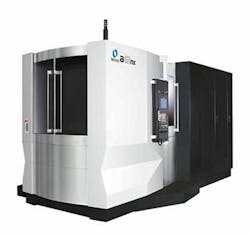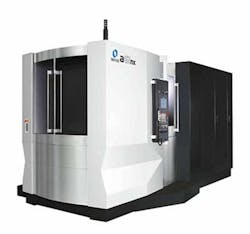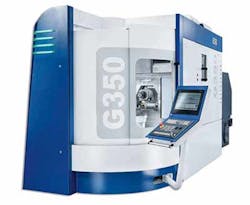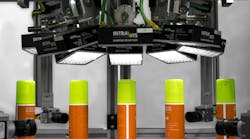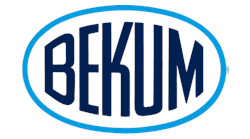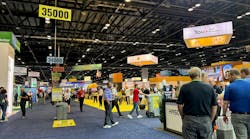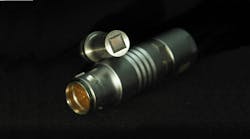Automation, increased workpiece accessibility and ergonomic design are just a few of the innovative features that suppliers of machining centers for making molds and tooling are using to enhance efficiency and productivity. The benefits of automation include greater capacity, improved quality and reductions in scrap; automation can also be used address the skilled-labor shortage.
GF Machining Solutions
"Machine downtime is the enemy," said Gisbert Ledvon, director of business development with GF Machining Solutions LLC, Lincolnshire, Ill., in a presentation at Amerimold in June in Novi, Mich. The average employee works 1,800 hours a year, he said. A machine that has not been automated can run only as long as an operator is present; an automated machine can run for about 8,700 hours annually.
Automation does more than just increase the number of available workhours, though.
"Automating only one machine could put your organization ahead of anyone with four machines that have not been automated, allowing you to produce more than four times as much with less than half the overhead costs," he said.
Automation for machining centers can range from automatic pallet changers on stand-alone machines to large-scale setups, such as a linear robot that is connected to multiple machines and magazines. This automation concept yields extreme flexibility, Ledvon said. If the changer unit is mounted on rails, it can serve a larger number of machines, while creating more space for magazines and peripheral equipment. While the machining centers are running, the linear robot is preparing tools and workpieces to be exchanged.
At the International Manufacturing Technology Show (IMTS) last month in Chicago, GF showcased its developments for Industry 4.0, which includes its rConnect platform, a central communications tool for remotely monitoring machining centers. The first phase of the rollout is Live Remote Assistance, which allows an expert from GF to remotely assist companies that are using GF machining centers.
Makino
John Bradford, manager of VMC (vertical machining centers/EDM (electrical discharge machining) turnkey and automation with Makino Inc., Mason, Ohio, said that companies must have control of their processes prior to automating. The processes must be stable, repeatable and predictable. His advice is not to start with high-complexity tasks.
"These are the ones that will be very expensive to automate," he said. The key to any automation project is to work closely with an automation partner to avoid costly mistakes and long delays. Also, companies must consider that lead times can be as long as six months for robots, rails and machine tools configured for automation.
Makino has upgraded two of its horizontal machining centers with changes that debuted at IMTS. The a51nx has a 22-inch X-axis and extended Y- and Z-axes of 25.2 inches, while the standard a61nx has a 28.7-inch X-axis, 25.6-inch Y-axis and extended Z-axis of 31.5 inches. Both have a number of features that enhance their productivity and user-friendliness. These include increased spindle torque, greater monitoring of cutting tools, advanced machine controls and integration with Makino's Professional 6, or Pro6, control. Also the Z-axes of both the a51nx and a61nx have been expanded, giving the machining centers maximum tool lengths of 16.9 inches and 20.1 inches, respectively.
Because of their increased torque, the machining centers achieve reduced hole-tapping times and faster acceleration and deceleration.
Grob Systems
Grob Systems Inc., Bluffton, Ohio, says its products boast the potential for lights-out machining and high-volume production. At Amerimold and IMTS, it highlighted its G-Series universal five-axis machining centers. Compared to some machining centers with
equivalent capacity, the G-Series units have a smaller footprint. The G-Series machining centers turn formerly multistep operations into an efficient, single setup, increasing outputs. With them, machinists can produce components quickly and accurately; reduce setups and increase spindle time; conduct deep-hole drilling at any angle in the same setup; produce slides, lifters and risers in a single setup; and machine all undercuts without additional setups.
At IMTS, Grob exhibited what it calls its "next generation of universal machines," the G-Series' G350 - Generation 2. Featuring a retractable spindle and swivel rotary table, the G350 –Generation 2 has faster tool changes and an expanded tool-magazine capacity, with the ability to handle a maximum part size of 23.6 inches in cylinder by 23.6 inches in height. It is also more compact, with an overall width of about 6.5 feet, compared to about 8 feet.
Grob also showed its mid-size G550T with a turning option for parts up to about 35.4 inches in cylinder. Like all G-Series models, the G350 and G550T feature a table with 225 degrees of rotation in the A-axis, and with continuous 360 degrees of rotation in the B-axis, along with the ability to completely invert the table for upside-down machining, enabling chips to fall away from the part.
Lisa Jo Lupo, correspondent
Contact:
GF Machining Solutions LLC, 847-913-5300, www.gfms.com
Grob Systems Inc., 419-358-9015, www.grobgroup.com
Makino Inc., 513-573-7200, www.makino.com
